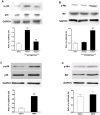Sustained oxidative stress causes late acute renal failure via duplex regulation on p38 MAPK and Akt phosphorylation in severely burned rats
- PMID: 23349934
- PMCID: PMC3547934
- DOI: 10.1371/journal.pone.0054593
Sustained oxidative stress causes late acute renal failure via duplex regulation on p38 MAPK and Akt phosphorylation in severely burned rats
Expression of concern in
-
Expression of Concern: Sustained Oxidative Stress Causes Late Acute Renal Failure via Duplex Regulation on p38 MAPK and Akt Phosphorylation in Severely Burned Rats.PLoS One. 2024 Feb 1;19(2):e0298294. doi: 10.1371/journal.pone.0298294. eCollection 2024. PLoS One. 2024. PMID: 38300978 Free PMC article. No abstract available.
Abstract
Background: Clinical evidence indicates that late acute renal failure (ARF) predicts high mortality in severely burned patients but the pathophysiology of late ARF remains undefined. This study was designed to test the hypothesis that sustained reactive oxygen species (ROS) induced late ARF in a severely burned rat model and to investigate the signaling mechanisms involved.
Materials and methods: Rats were exposed to 100°C bath for 15 s to induce severe burn injury (40% of total body surface area). Renal function, ROS generation, tubular necrosis and apoptosis, and phosphorylation of MAPK and Akt were measured during 72 hours after burn.
Results: Renal function as assessed by serum creatinine and blood urea nitrogen deteriorated significantly at 3 h after burn, alleviated at 6 h but worsened at 48 h and 72 h, indicating a late ARF was induced. Apoptotic cells and cleavage caspase-3 in the kidney went up slowly and turned into significant at 48 h and 72 h. Tubular cell ROS production shot up at 6 h and continuously rose during the 72-h experiment. Scavenging ROS with tempol markedly attenuated tubular apoptosis and renal dysfunction at 72 h after burn. Interestingly, renal p38 MAPK phosphorylation elevated in a time dependent manner whereas Akt phosphorylation increased during the first 24 h but decreased at 48 h after burn. The p38 MAPK specific inhibitor SB203580 alleviated whereas Akt inhibitor exacerbated burn-induced tubular apoptosis and renal dysfunction. Furthermore, tempol treatment exerted a duplex regulation through inhibiting p38 MAPK phosphorylation but further increasing Akt phosphorylation at 72 h postburn.
Conclusions: These results demonstrate that sustained renal ROS overproduction induces continuous tubular cell apoptosis and thus a late ARF at 72 h after burn in severely burned rats, which may result from ROS-mediated activation of p38 MAPK but a late inhibition of Akt phosphorylation.
Conflict of interest statement
Figures







References
-
- Coca SG, Bauling P, Schifftner T, Howard CS, Teitelbaum I, et al. (2007) Contribution of acute kidney injury toward morbidity and mortality in burns: a contemporary analysis. Am J Kidney Dis 49: 517–523. - PubMed
-
- Mustonen KM, Vuola J (2008) Acute renal failure in intensive care burn patients (ARF in burn patients). J Burn Care Res 29: 227–237. - PubMed
-
- Chrysopoulo MT, Jeschke MG, Dziewulski P, Barrow RE, Herndon DN (1999) Acute renal dysfunction in severely burned adults. J Trauma 46: 141–144. - PubMed
-
- Holm C, Horbrand F, von Donnersmarck GH, Muhlbauer W (1999) Acute renal failure in severely burned patients. Burns 25: 171–178. - PubMed
Publication types
MeSH terms
Substances
LinkOut - more resources
Full Text Sources
Other Literature Sources
Research Materials

